- Anatomical terminology
- Skeletal system
- Skeleton of trunk
- Skull
- Skeleton of upper limb
- Skeleton of lower limb
- Joints
- Muscles
- Heart
- Blood vessels
- Lymphatic system
- Nervous system
- Respiratory system
- Digestive system
- Urinary system
- Female reproductive system
- Male reproductive system
- Endocrine glands
- Eye
- Ear
Neurocranium
The neurocranium (Latin: neurocranium) is the part of the skull enclosing the cranial cavity. It is made up of 8 bones: the temporal bones (2), parietal bones (2), sphenoid bone, frontal bone, ethmoid bone, and occipital bone.
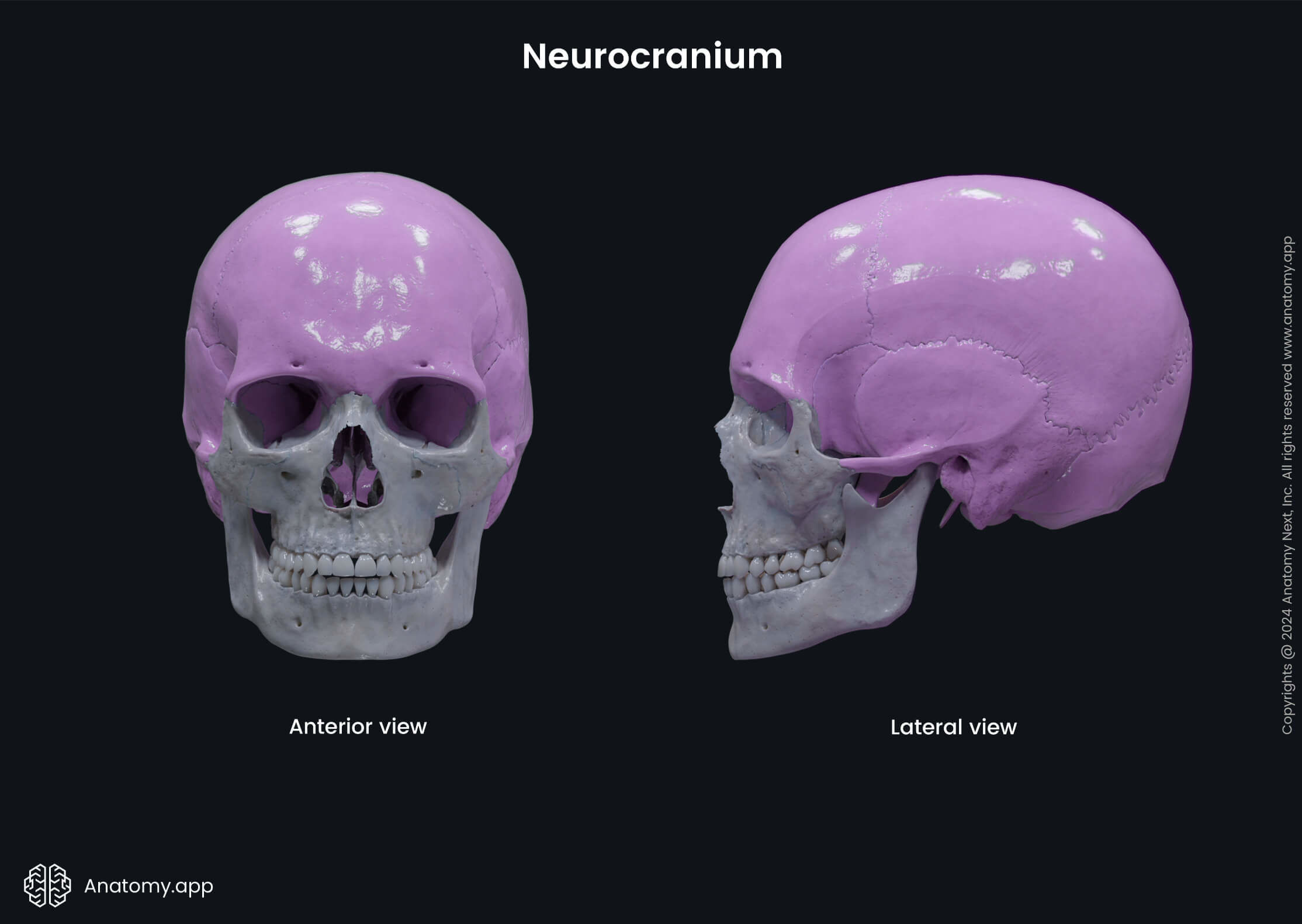
The neurocranium contains all parts of the brain, including the cerebrum, cerebellum, and brainstem. The primary function of the neurocranium is to provide a framework for the head and protection for the brain and its associated sensory structures.
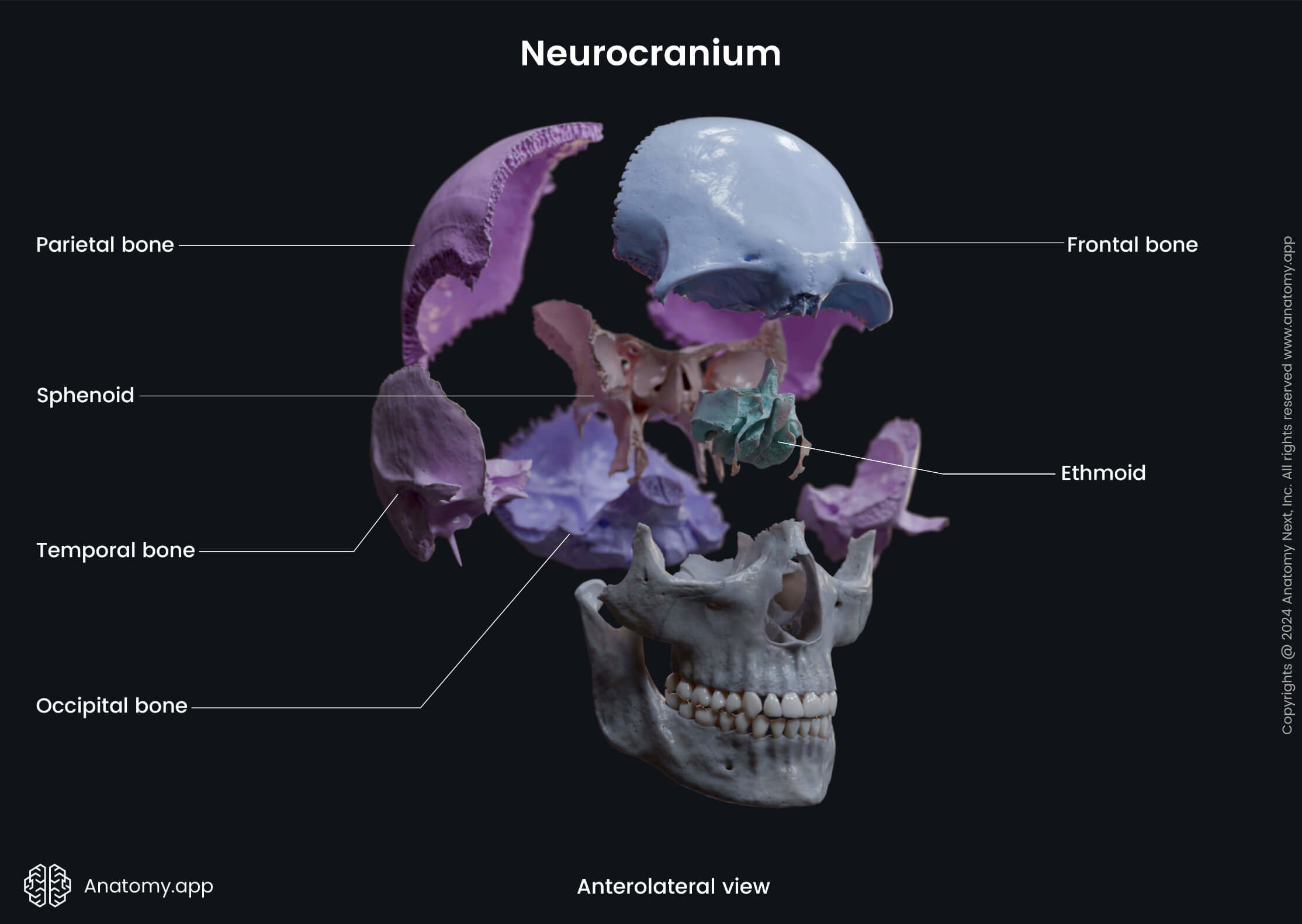
On the surface of the neurocranium a wide array of markings and indents can be seen. The most noticeable of these mentioned markings are sutures. Cranial sutures are fibrous joints that bind together the neurocranial bones at their junctures.
Other observable features include the arterial grooves and broad depressions on the inner surface called impressions of cerebral gyri. These impressions correspond to the convolutions of the brain called cerebral gyri.
Bones of neurocranium
There are two paired and four single or unpaired bones forming the neurocranium. Paired bones are found symmetrically located at opposite sides of the skull. The paired bones of the neurocranium are:
Unpaired bones are symmetrical bones located along the midline of the skull. The four unpaired bones of the neurocranium are the following:
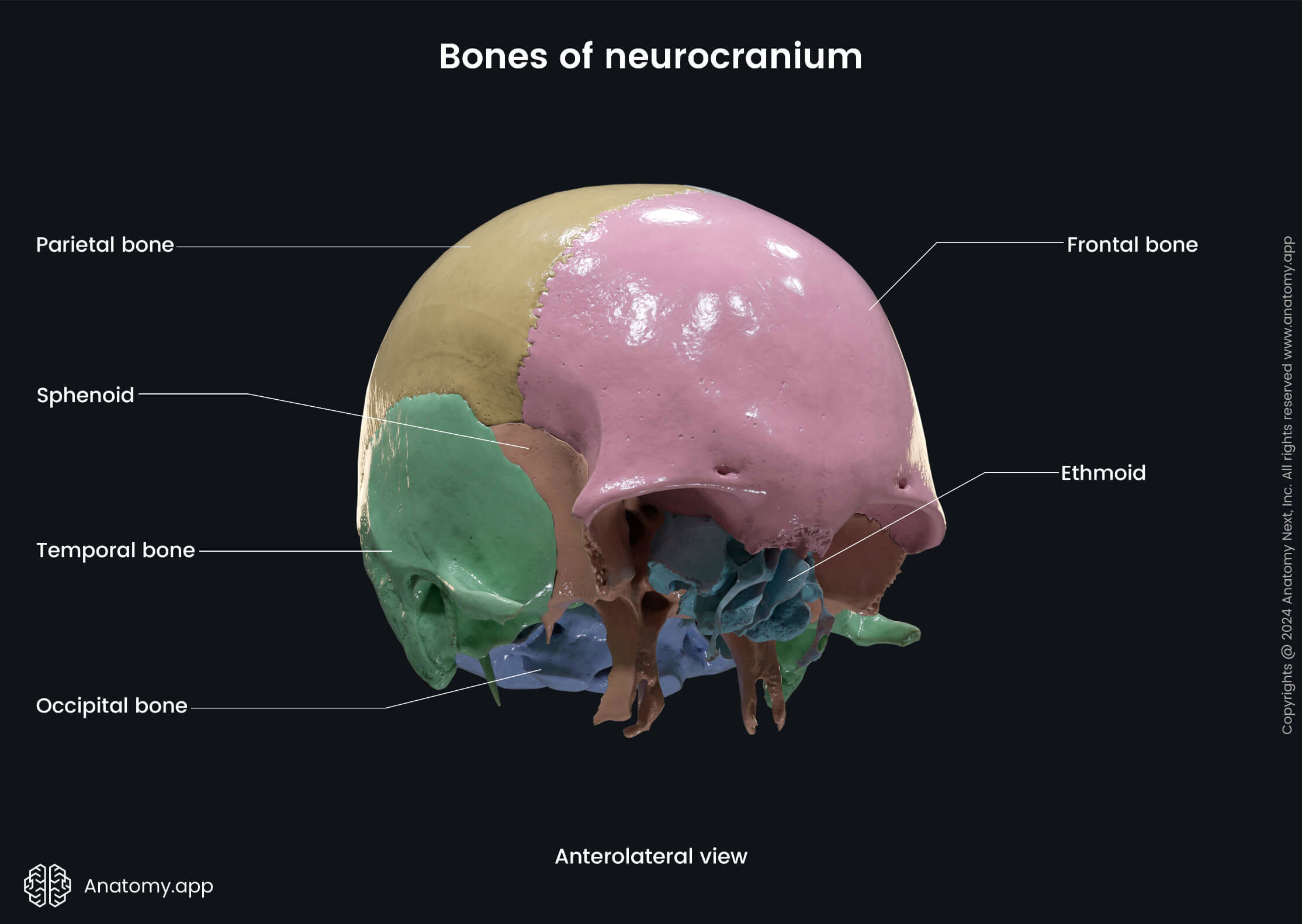
Paired bones of neurocranium
Temporal bone
The temporal bones are complex bones located on each side of the neurocranium. In addition to providing attachment sites for multiple muscles, the temporal bones also house the auditory and vestibular organs. Each temporal bone can be further divided into squamous, mastoid, petrous, and tympanic parts.
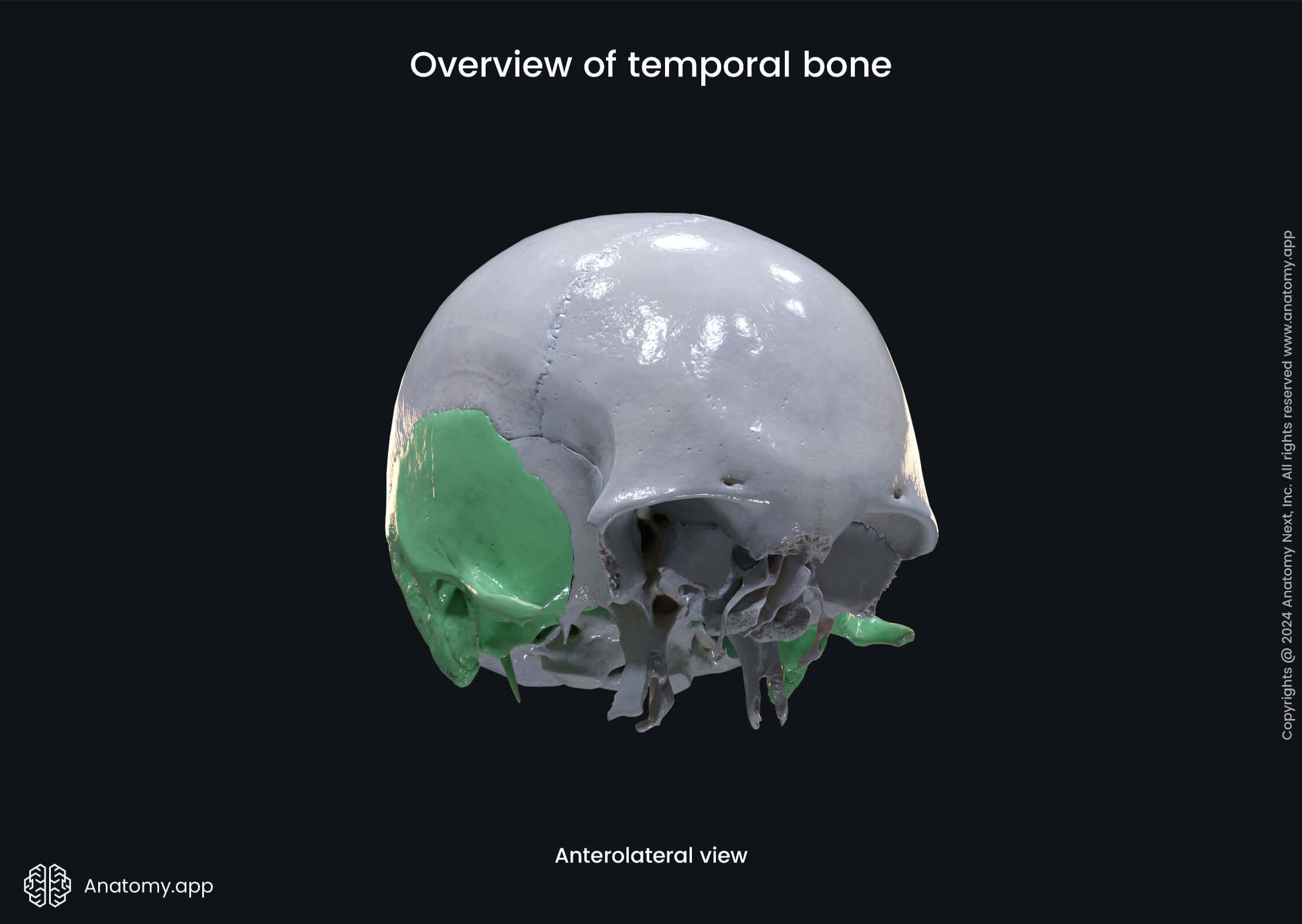

The squamous part of the temporal bone is the superiorly located flat piece of bone that participates in forming the lateral neurocranial wall. The squamous part articulates superiorly with the parietal bone contributing to the formation of the squamous suture. Anteriorly, at its confluence with the sphenoid bone, the sphenosquamous suture is formed.
The mastoid part is located posteroinferior to the squamous part of the temporal bone. This part articulates superiorly with the parietal bone forming the parietomastoid suture. Posteriorly, the mastoid part of the temporal bone articulates with the occipital bone forming the occipitomastoid suture.
The petrous part of the temporal bone is pyramid-shaped and is located at the base of the neurocranium. The petrous part holds the vestibular and auditory organs. Superiorly, the petrous part transitions into the squamous part, forming the petrosquamous fissure, while the petrous part links up with the tympanic part forming the petrotympanic fissure.
The tympanic part is located in between all the above-mentioned parts of the temporal bone. The tympanic part is situated inferior to the squamous part, lateral to the petrous part, and anterior to the mastoid part.
Parietal bone
The parietal bones are irregular, quadrilateral bones that form a large portion of the neurocranial roof and sides. Superiorly, the parietal bones articulates with the contralateral parietal bone forming the sagittal suture. Anteriorly, both parietal bones articulate with the frontal bone and form the coronal suture.
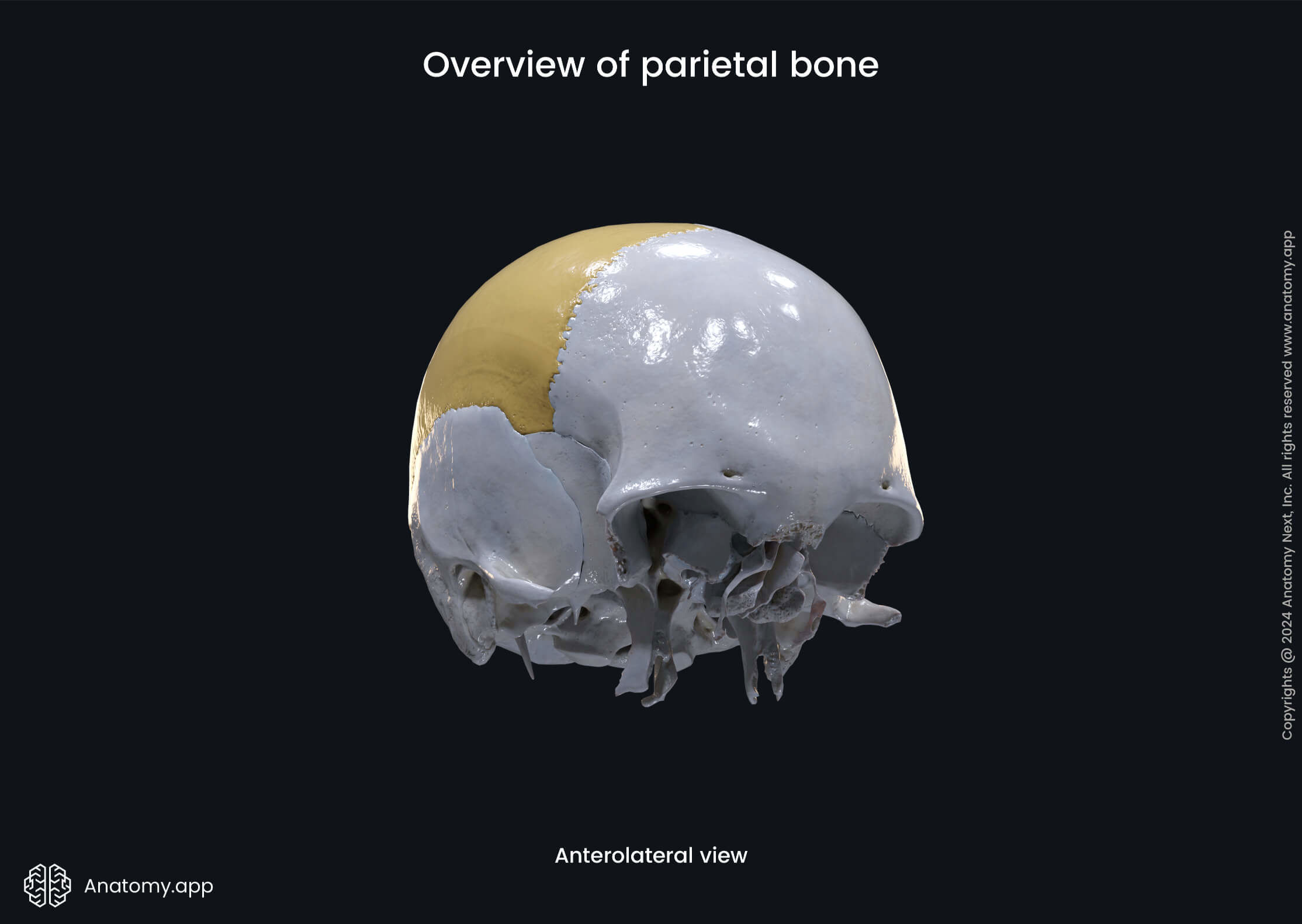
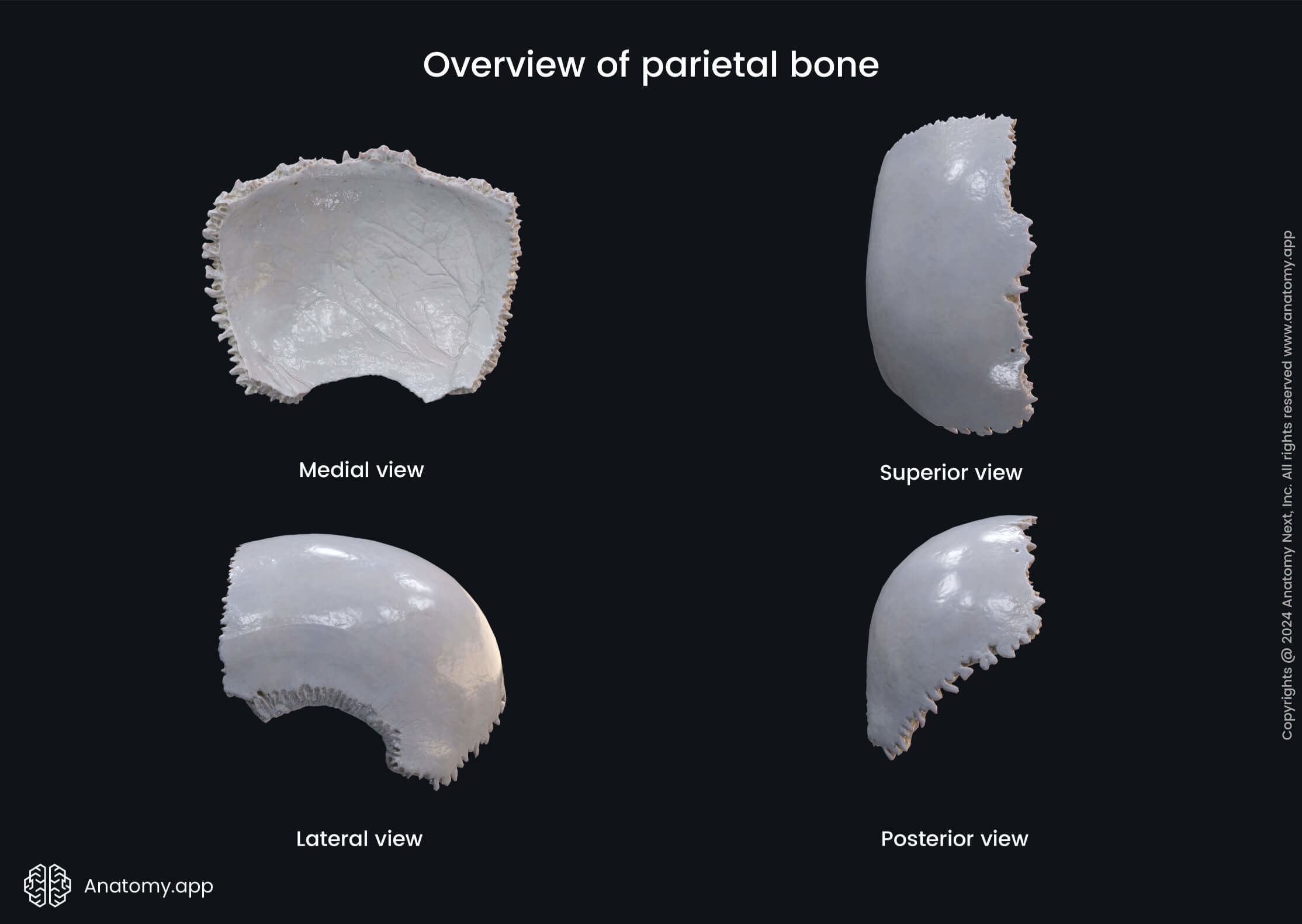
On lateral sides of the neurocranium, the parietal bones attach to the sphenoid bone forming the sphenoparietal suture. The squamosal suture is formed by joining up with the squamous part of the temporal bone. Posteriorly, the parietal bones are connected with the occipital bone forming the lambdoid suture and the lambda. The lambda is the intersection of the lambdoid sutures and sagittal suture.
Unpaired bones of neurocranium
Sphenoid bone
The sphenoid bone, positioned in the anterior part of the neurocranium, is a symmetrical bone which resembles the shape of a butterfly. The sphenoid bone has several parts. The central part is known as the body of the sphenoid. Two wing-like structures known as the greater wing and lesser wing extend from each side of the body of the sphenoid.
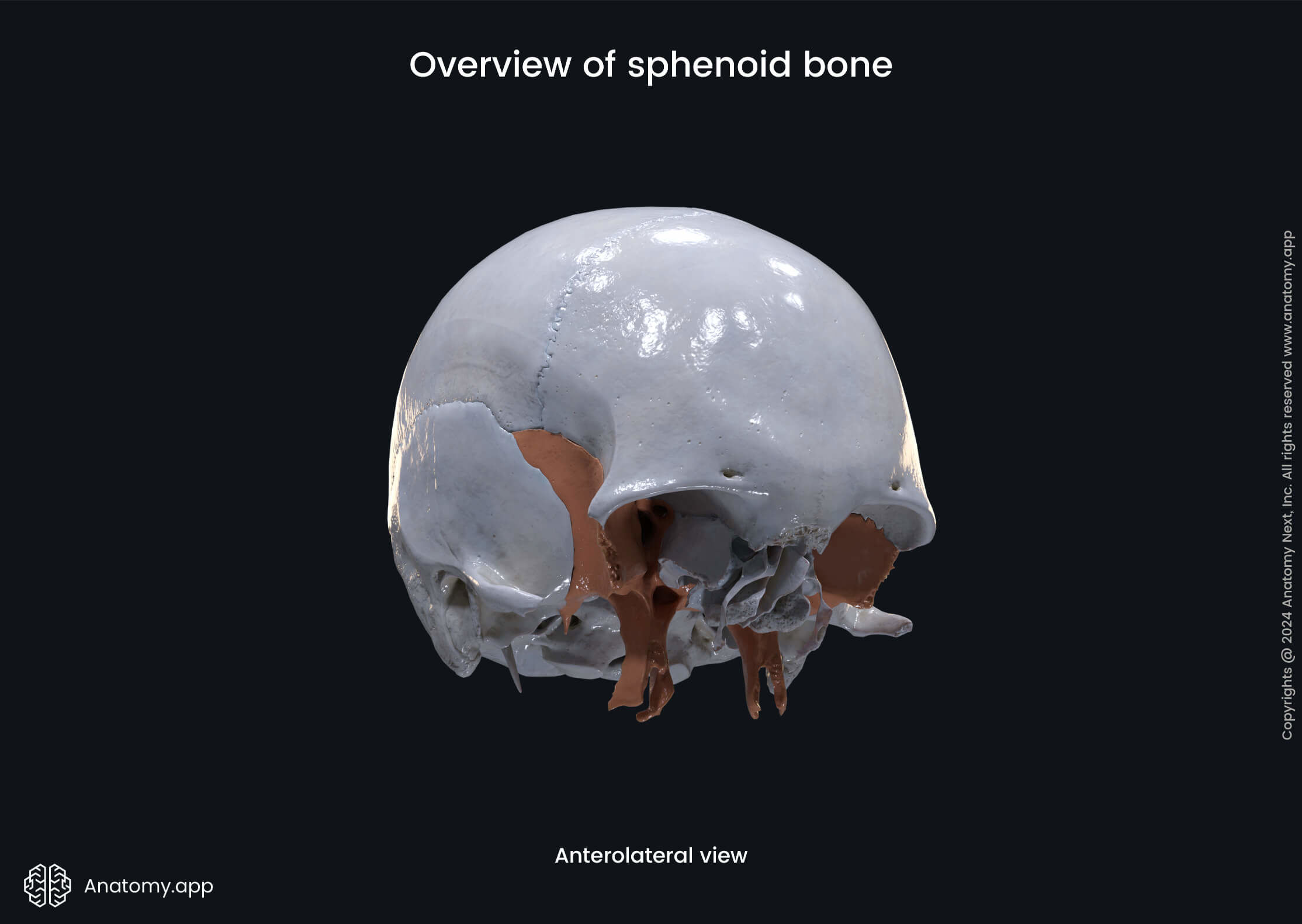
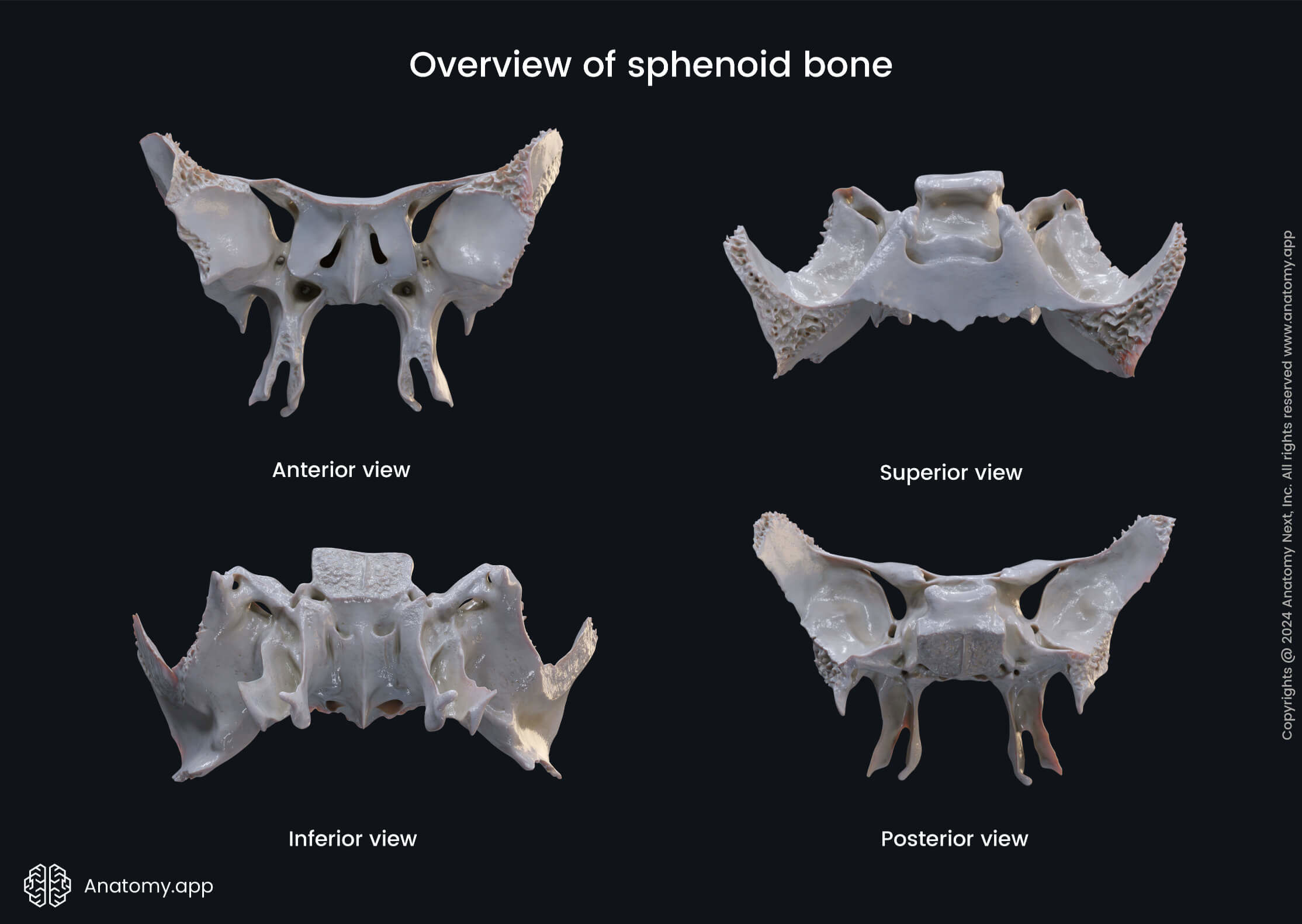
At the center of the sphenoid bone is sella turcica - a saddle-shaped depression, which houses the hypophysis. Anteriorly, the sphenoid bone meets the frontal bone at the sphenofrontal suture. Also anteriorly the sphenoid is connected with the cribriform plate of the ethmoid bone forming the sphenoethmoidal suture.
Posterolaterally, the sphenoid bone articulates with both temporal bones forming the sphenosquamosal sutures. Posteriorly joins up with the basilar part of the occipital bone forming the sphenooccipital synchondrosis. In the pterion region, at the junction of sphenoid, temporal, parietal, and frontal bones, the sphenoid bone articulates with the parietal bone forming the sphenoparietal suture.
Frontal bone
The frontal bone forms a large share of the anterior neurocranium giving the forehead a smooth curvature and protecting the frontal lobe. The frontal bone contains the frontal sinuses and forms connections with surrounding neurocranial bones and most of the viscerocranial bones.
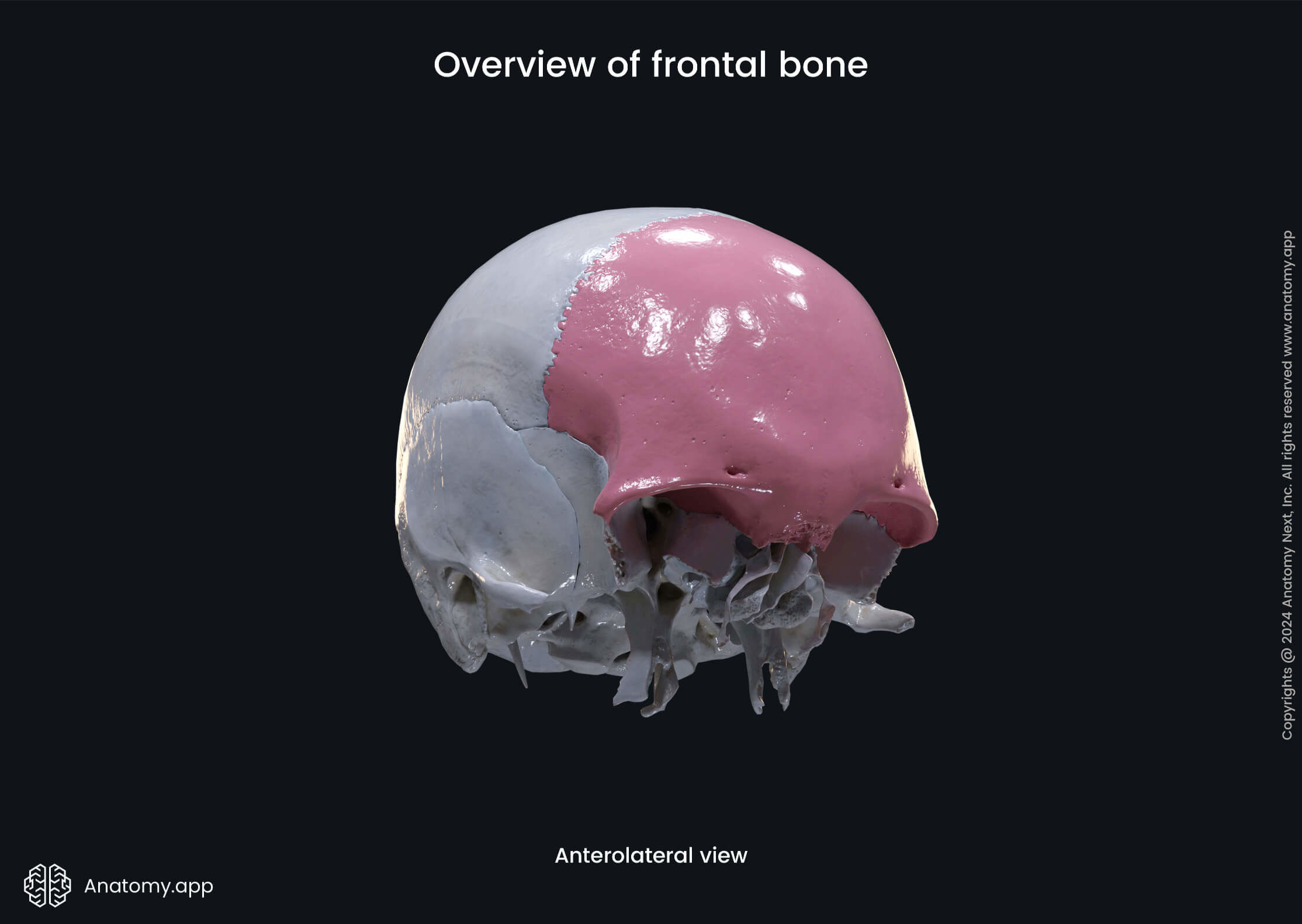

The frontal bone can be further divided into the squamous part forming most of the forehead, the orbital part forming the roof of the orbit, and the nasal part articulating with the nasal bones forming the frontonasal suture.
Laterally, the frontal bone articulates with the zygomatic bone forming the frontozygomatic suture. In children, the metopic suture can be observed on the midline of the frontal bone. Also, together with the maxilla and nasal bones, the frontal bone forms the root of the nose.
Occipital bone
The occipital bone is a trapezoid-shaped bone that forms the posterior portion of the neurocranium and provides protection to the posterior part of the brain, cerebellum, and part of the brainstem. At the base of the occipital bone is an oval opening known as the foramen magnum - the largest opening of the skull.

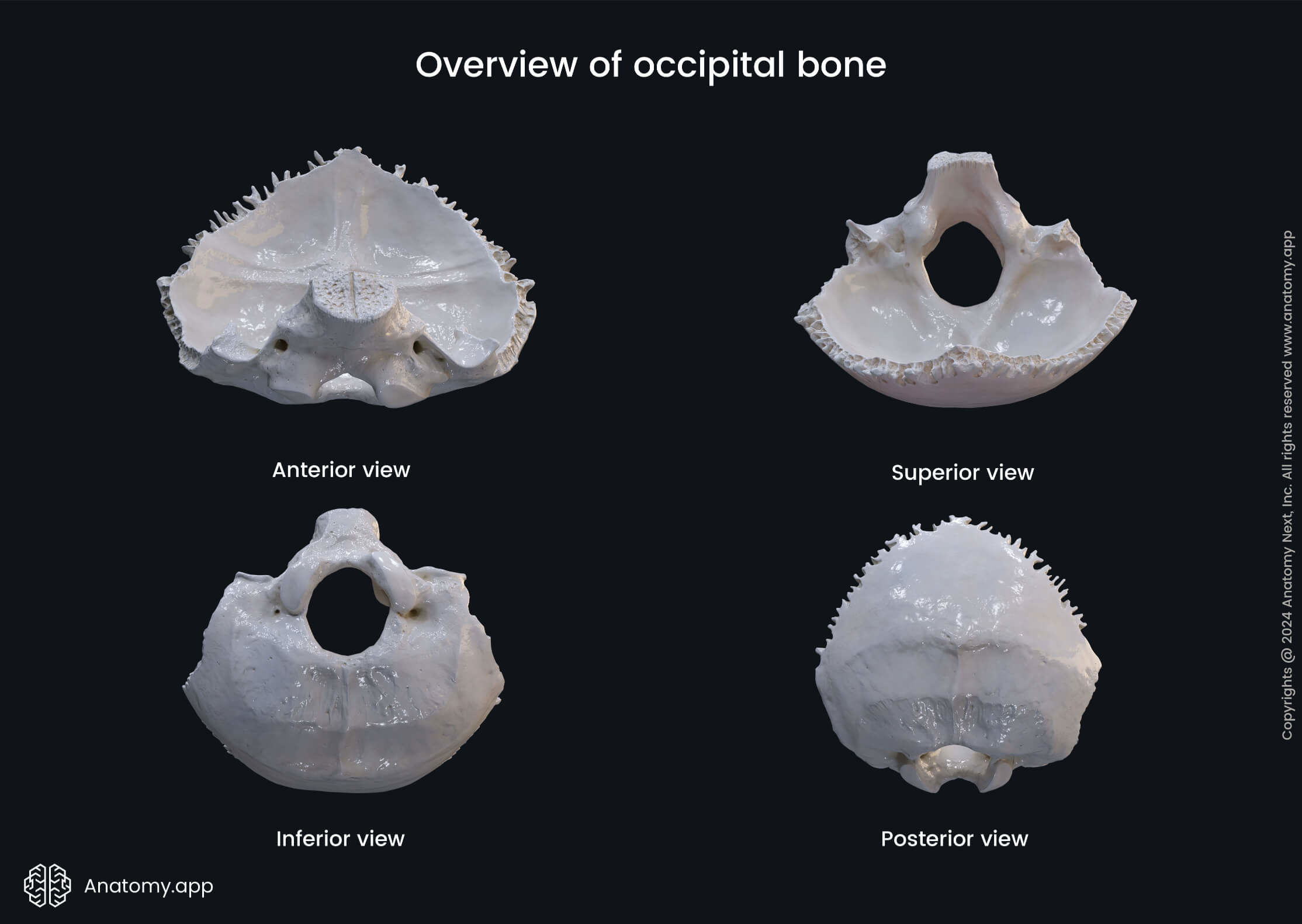
The occipital bone's basilar part articulates with the petrous part of the temporal bone forming the occipitomastoid suture, and anteriorly meets the sphenoid bone at the sphenooccipital synchondrosis. Superiorly, the occipital bone articulates with the parietal bones forming the lambda and lambdoid suture. On the outer part of the occipital bone, the external occipital protuberance can be found.
Ethmoid bone
The ethmoid bone is located at the front of the neurocranium. The ethmoid is a porous bone that separates the nasal cavity from the anterior cranial fossa and contributes to the orbit, nasal cavity, nasal septum, and anterior cranial fossa.
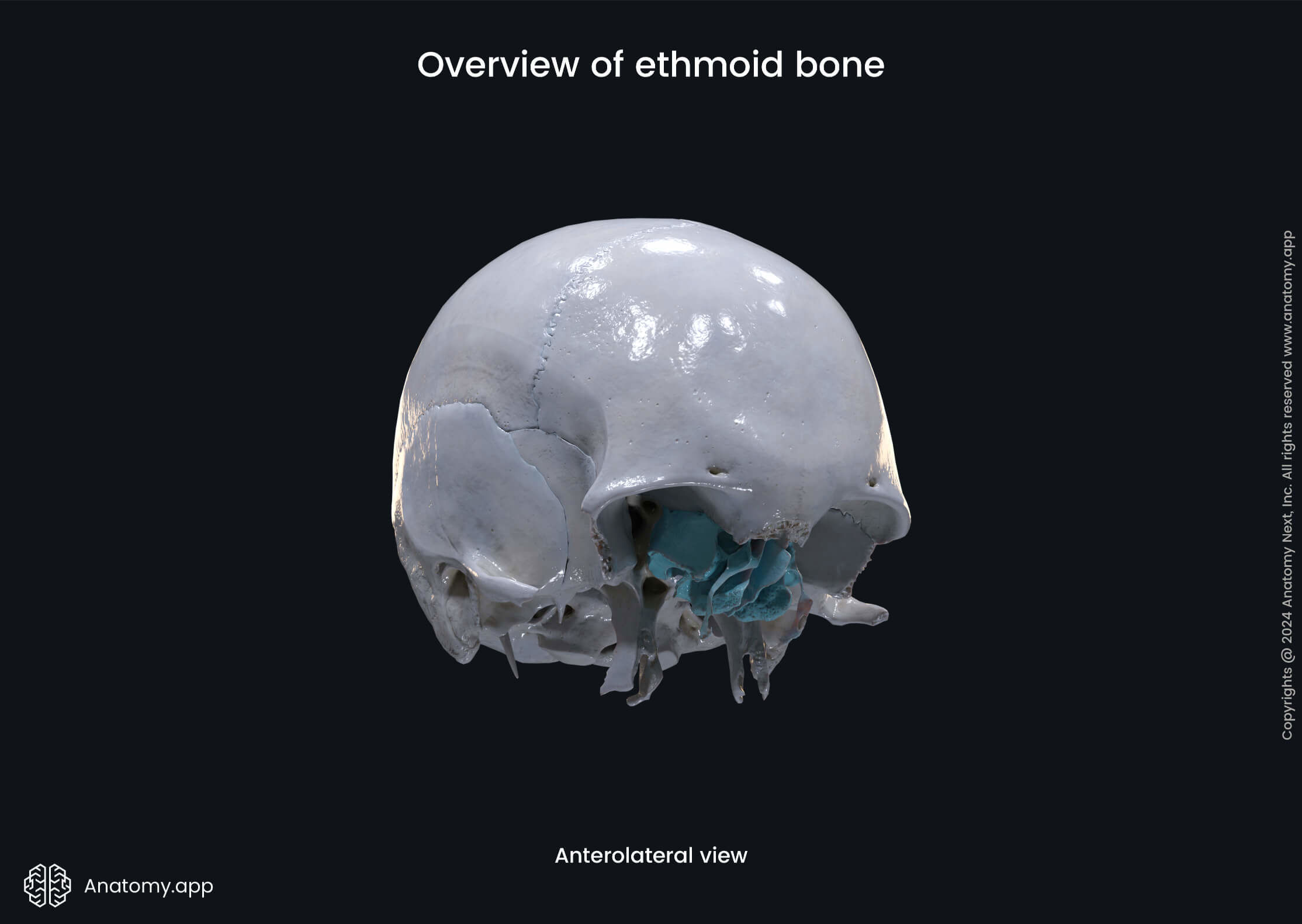
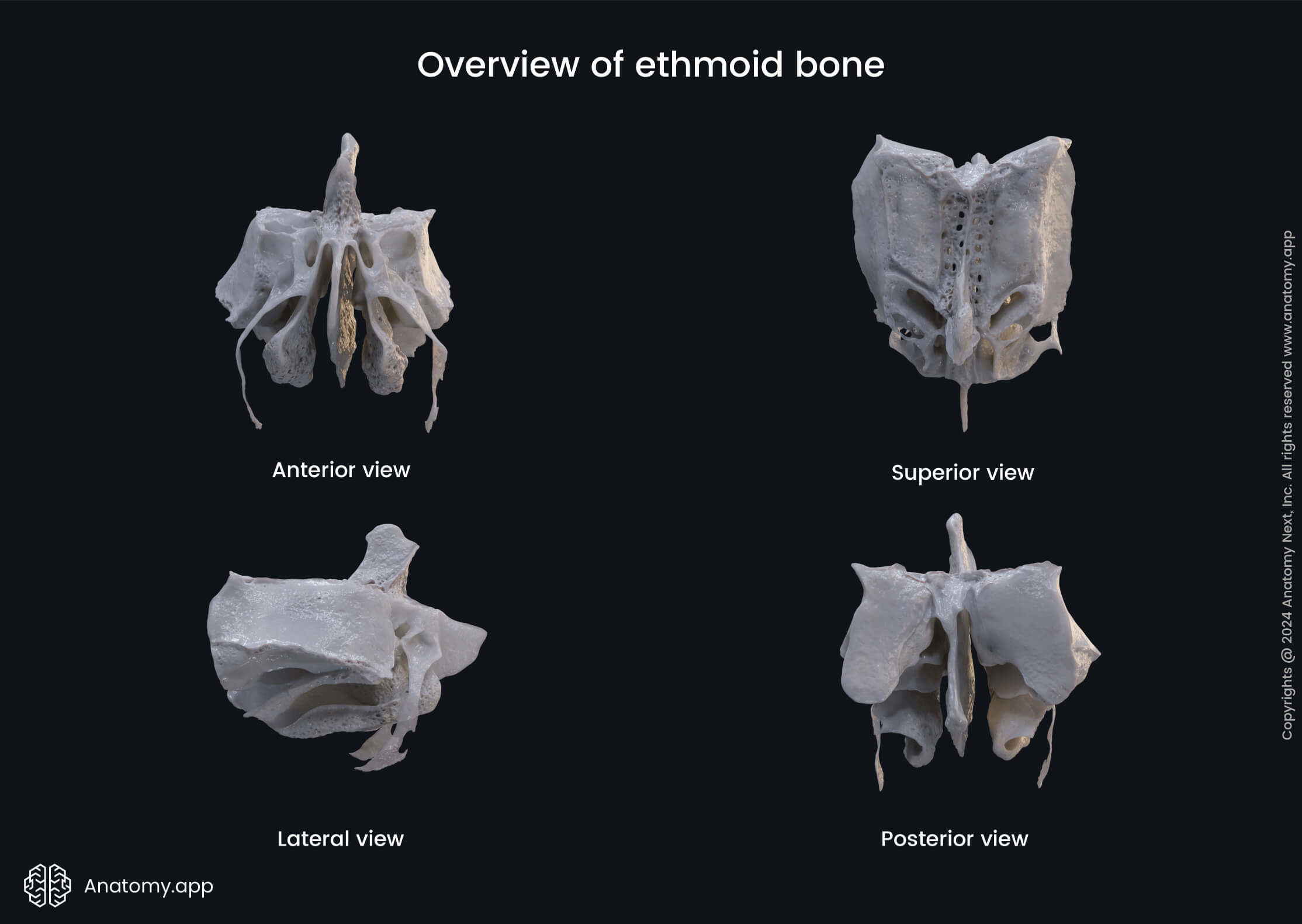
The ethmoid articulates with 13 other bones: the frontal, nasal, lacrimal, sphenoid, and palatine bones, maxilla, inferior nasal conchae, and vomer. Each ethmoid bone can be further divided into three parts: the cribriform plate, perpendicular plate, and ethmoid labyrinth.
The cribriform plate forms the superior surface of the ethmoid bone, with the crista galli extending superiorly into the anterior cranial fossa, acting as an attachment site for the cerebral falx. The cribriform plate contains numerous foramina (cribriform foramina) through which the olfactory nerve (CN I) fibers pass.
The perpendicular plate of the ethmoid forms a part of the nasal septum and inferiorly articulates with the vomer, separating the nasal cavity into two parts. And the ethmoid labyrinth descends inferiorly from the cribriform plate and forms the middle and superior nasal conchae and ethmoidal air cells.
References:
- Drake, R. L., Vogl, A. W., & Mitchell, A. W. M. (2019). Gray’s Anatomy for Students: With Student Consult Online Access (4th ed.). Elsevier.
- Norton, N. S. (2016). Osteology. In Netter's Head and Neck Anatomy for Dentistry (3rd ed., pp. 25–64). Elsevier.